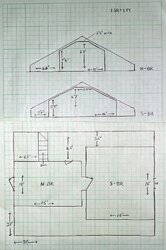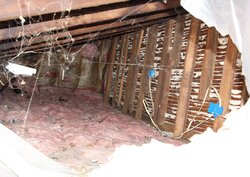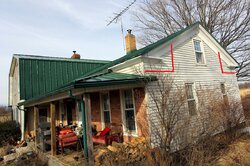So I've got some advice from here in the past, and did some reading online for what to do with these cape cod upstairs. I think I have a better idea now, and my week off is fast approaching (week after next) so I wanted to run it by you all one final time. I still think this is something I can do, and looking forward to the experience since I'm pretty handy but haven't really ever tried major home renovations. I plan on moving sometime in 2-10 years, this is not the home I want to stay in forever. If I was planning on staying I'd gut the walls take off siding, whatever, and use the best stuff. But what I am looking for now is just a quick best bang for buck upgrade to at least make the upstairs bearable.
A quick review of my home. A small 1900 cape with a large full 2 story addition in 1990. The upper level of the cape has 2 rooms. 1 room had been renovated prior to me moving in 2008. It has sheetrock walls and fiberglass batts. The other room has uninsulated walls/ceilings (plaster and lath) with only fiberglass on the floor of the crawl space behind the knee walls. Nothing is air sealed either. The sloped wall/ceiling is built right on the roof rafters.
Here is a to scale sketch I made of the upper level:

The two rooms are different widths right now. The area along the outsides of the 31' edge and the crawl spaces behind the knee walls.
Here is a shot from inside the knee wall attic on the side with uninsulated plaster wall/ceiling...

There is no ventilation. That is what caused me to change direction recently. I had planned to add ventilation but in this house it would be nearly impossible and cause other problems. I've read this is typical problem with cape cods. For one thing I have no eaves. And only one gable end is exposed, and not really enough exposed space in the crawl space to put a decent size vent in. And the one bedroom that's more recently remodelled I'd have to tear out to ventilate and I don't want to do that (FG between drywall and roof, only way to ventilate would be to tear down ceiling and remove FG, and still no good way of bringing fresh air in). Some reading revealed the unvented approach can be ok... http://www.energyauditingblog.com/unvented-attics/

The cape cod half of the house. I drew red lines to show where the knee wall attic space was. Doesn't leave enough room to put a decent size gable vent to draw air in, and no eave vents. The front of the house the eave end adjoins the porch roof, on the back side its the same curvy white metal trim with rain gutters.
I thought about just trying to add insulation but it would be too difficult to get it in the very small cavity between the angled plaster wall/ceiling and the roof (less than 4"). So here is the plan. Going to tear down the plaster walls and ceiling. If I can't ventilate properly I've read I should do the opposite and seal/insulate the outer envelope... along the roof and the eave and gable ends. I'll expand the floor over the whole width (removing the FG on the floor). So the whole space will be bedroom - I may add a similar 'knee wall' but it will be on the interior of the room and turn the sides into storage space that within the conditioned area.
I'm going to seal best I can. I'll have to remove most all the insulation first and seal everything up with spray foam on the eave and gable ends, then insulate. I was just going to use FG batts but should I look into something else? What about those rigid foam boards? Could I do FG between the rafters and then a thin layer of foam board on them and then drywall on the foam board? The roof rafters measure 2 3/4" wide and 3 1/2" tall. 2' on center (actually they seem to measure 24 1/4"). I was wondering if I could maybe add a couple inches to these using 2x2's to get deeper cavity but I suppose if I use that rigid foam I could add thickness to the insulation without needing to use the cavity right? There is a stairway (unused) down one side that I will remove and cover up. Right now it bisects the knee wall attic and creates a section that is inaccessible. Plus I'd like the extra space in the laundry room below it.
I plan on getting this stuff for my air sealing:

More expensive than the $3 cans of Gaps and Cracks but I hear the gun gives you a lot better control and results, and a lot less waste. I also bought a respirator and tyvec suit for working in that nasty dirty dusty moose poop covered knee wall attic. Anything I'm missing or other recommendations?
A quick review of my home. A small 1900 cape with a large full 2 story addition in 1990. The upper level of the cape has 2 rooms. 1 room had been renovated prior to me moving in 2008. It has sheetrock walls and fiberglass batts. The other room has uninsulated walls/ceilings (plaster and lath) with only fiberglass on the floor of the crawl space behind the knee walls. Nothing is air sealed either. The sloped wall/ceiling is built right on the roof rafters.
Here is a to scale sketch I made of the upper level:

The two rooms are different widths right now. The area along the outsides of the 31' edge and the crawl spaces behind the knee walls.
Here is a shot from inside the knee wall attic on the side with uninsulated plaster wall/ceiling...

There is no ventilation. That is what caused me to change direction recently. I had planned to add ventilation but in this house it would be nearly impossible and cause other problems. I've read this is typical problem with cape cods. For one thing I have no eaves. And only one gable end is exposed, and not really enough exposed space in the crawl space to put a decent size vent in. And the one bedroom that's more recently remodelled I'd have to tear out to ventilate and I don't want to do that (FG between drywall and roof, only way to ventilate would be to tear down ceiling and remove FG, and still no good way of bringing fresh air in). Some reading revealed the unvented approach can be ok... http://www.energyauditingblog.com/unvented-attics/

The cape cod half of the house. I drew red lines to show where the knee wall attic space was. Doesn't leave enough room to put a decent size gable vent to draw air in, and no eave vents. The front of the house the eave end adjoins the porch roof, on the back side its the same curvy white metal trim with rain gutters.
I thought about just trying to add insulation but it would be too difficult to get it in the very small cavity between the angled plaster wall/ceiling and the roof (less than 4"). So here is the plan. Going to tear down the plaster walls and ceiling. If I can't ventilate properly I've read I should do the opposite and seal/insulate the outer envelope... along the roof and the eave and gable ends. I'll expand the floor over the whole width (removing the FG on the floor). So the whole space will be bedroom - I may add a similar 'knee wall' but it will be on the interior of the room and turn the sides into storage space that within the conditioned area.
I'm going to seal best I can. I'll have to remove most all the insulation first and seal everything up with spray foam on the eave and gable ends, then insulate. I was just going to use FG batts but should I look into something else? What about those rigid foam boards? Could I do FG between the rafters and then a thin layer of foam board on them and then drywall on the foam board? The roof rafters measure 2 3/4" wide and 3 1/2" tall. 2' on center (actually they seem to measure 24 1/4"). I was wondering if I could maybe add a couple inches to these using 2x2's to get deeper cavity but I suppose if I use that rigid foam I could add thickness to the insulation without needing to use the cavity right? There is a stairway (unused) down one side that I will remove and cover up. Right now it bisects the knee wall attic and creates a section that is inaccessible. Plus I'd like the extra space in the laundry room below it.
I plan on getting this stuff for my air sealing:
More expensive than the $3 cans of Gaps and Cracks but I hear the gun gives you a lot better control and results, and a lot less waste. I also bought a respirator and tyvec suit for working in that nasty dirty dusty moose poop covered knee wall attic. Anything I'm missing or other recommendations?
Last edited:


